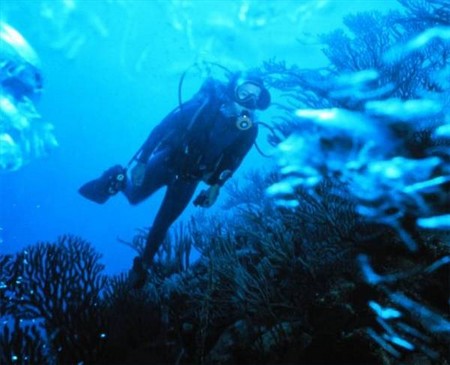Weighed down
Most people are naturally neutrally buoyant. With a normal relaxed lung volume, they neither float nor sink. If they take a deep breath, they will float. If they empty their lungs, they will sink.
As soon as a diver puts on a diving suit, more water is displaced by the suit and the diver will float. It is necessary to strap on some ballast (weight) to counteract the buoyancy of the suit. The most convenient and common type of weight is lead.
Most divers simply thread their block-style lead weights onto a length of 5-cm (2-inch) webbing and use it as a belt. If you require more comfort than a belt provides, a harness can help.
Another way to carry lead is in the form of lead shot, which requires a shot belt or a belt that takes shot in pouches. If you use a lightweight aluminium cylinder, you may prefer to strap some V-shaped lead to that.
There are other systems that allow you to strap part of the weight to your tank. Otherwise it should be possible to release all ballast in an emergency – that’s why all systems have a quick-release buckle.
Many variables
Divers will need to work out how much lead to carry, but there are many factors to take into account when making this decision. One of these is the size and thickness of your suit.
A thick neoprene diving suit with a bulky jacket over it displaces more water than a thin suit alone, making you more buoyant. You will, therefore, need more lead if you are wearing a thicker suit.
The buoyancy of any equipment is also important. Aluminium tanks can be almost neutral, whereas steel tanks are always very heavy even when immersed. Also the air in the tank has weight. A full 12-L (80-cubic-foot) cylinder is over 3 kg (6 pounds) heavier than it is when it is empty.
The density of the water in which you are diving is also a factor. Salt water is denser than fresh water so you will need to carry more weight when diving in the ocean than in a lake.
Checking your weight
When using new equipment at a new location, every diver will need to do a weight check. Whatever system you use and however much weight you use, you should check that you are neutrally buoyant with a nearly empty tank and full equipment. Do this by checking that you float vertically with your eyes just above the surface with a full lung of air. Make sure that you sink under the water when you exhale fully.
How much lead should I use?
Many divers learn to dive with plenty of lead because it helps keep them on the bottom of the pool at a time when they may be nervous and breathing in large volumes of air. However, some divers will carry large amounts of ballast during routine dives. As a result, they never get to experience the joy of diving completely weightless, and they are always having to fin forward in order to stay at one depth. This means that they use a lot more air than they should. A relaxed diver has just the right amount of weight to complete the dive with a tank that is nearly empty.
